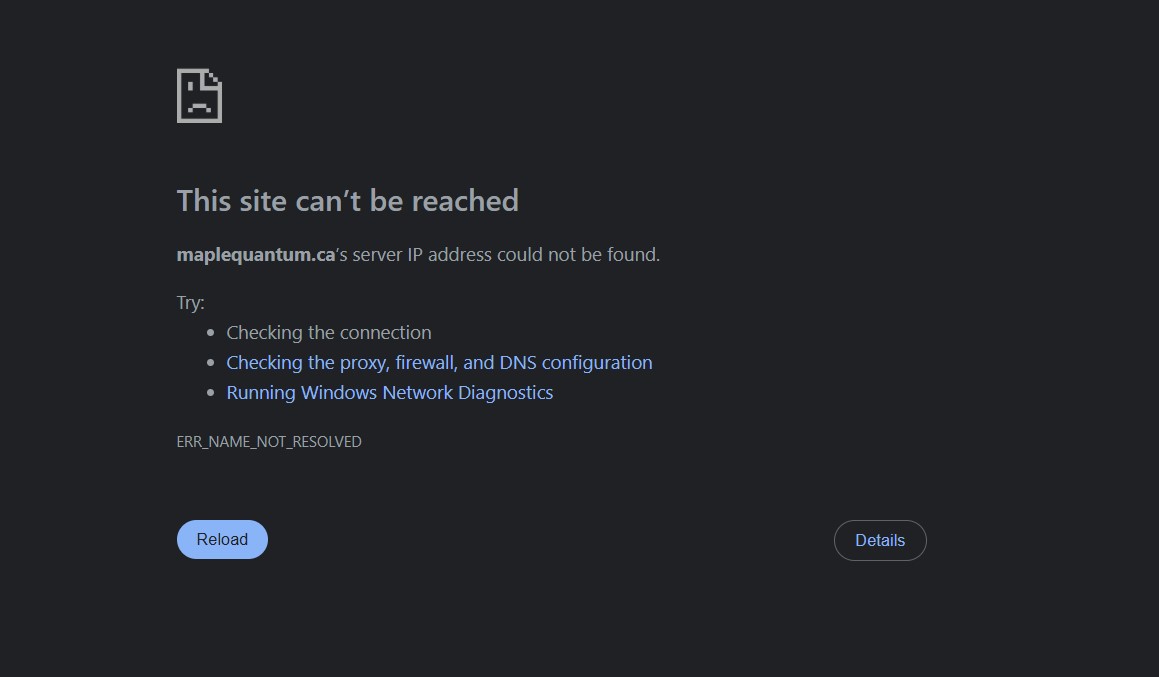MapleQuantum.ca Scam Review -A Scam In Disguise
MapleQuantum.ca displays multiple structural and operational features commonly seen in high-risk or deceptive online investment platforms. The combination of opaque ownership, bold performance promises without verifiable proof, aggressive onboarding/upsell behavior reported for similar operations, and recurring reports of withdrawal friction creates a risk profile that investors should treat as very high. Below is a thorough, rotated analysis that explains why.
Opening — polished veneer, missing foundations
MapleQuantum.ca arrives with the typical trappings designed to lower suspicion: a polished website, modern fintech language, and promises of algorithmic or “quantum”-enhanced trading strategies. The site’s visuals and copy signal sophistication, often implying institutional capability and technical edge. That presentation is persuasive by design — it primes visitors to equate slick design with genuine competence.
But in regulated financial services, credibility is earned through transparency: verifiable corporate registration, named executives with traceable professional histories, clear regulator licences, audited performance reports, and accessible, consistent withdrawal processes. Where any of those pillars are absent or unclear, the polished look is no substitute for substance.
Who’s behind MapleQuantum.ca — accountability matters
One of the very first checks for any online broker or investment service is identifying the legal entity behind it. Key questions are simple and practical: who owns the platform, where is it incorporated, and which jurisdiction supervises it?
With MapleQuantum.ca, the publicly visible corporate picture is vague. Ownership and management information is minimal or masked, contact addresses (if shown) are generic or non-specific, and leadership bios (when present) lack verifiable professional footprints. In finance, this is not a trivial omission — it’s the difference between an entity that can be held to account and one that can quietly vanish or rebrand if scrutiny increases.
Anonymity or heavy use of domain privacy services creates enforcement friction: regulators, law enforcement, or harmed customers all struggle to identify the correct legal entity to investigate or sue. That lack of traceability is one of the strongest single-factor risk signals.
Regulation & licensing — the missing safety net
Legitimate brokers and asset managers operate under regulatory regimes that enforce capital handling, disclosure, client fund segregation, and complaint procedures. A credible platform typically displays licence numbers, regulator names, and links that let anyone confirm the firm’s permission to operate.
MapleQuantum.ca’s public materials do not include clear, verifiable regulator registrations or licence identifiers. Instead, the site leans on compliant-sounding language and assurances about security and oversight without the concrete details an investor needs to independently verify those claims.
Operating without visible regulatory backing has three practical consequences:
-
No third-party oversight: No regulator is routinely examining financial practices or solvency.
-
Limited investor protections: Compulsory segregation of client funds and compensation schemes typically do not apply.
-
Harder dispute resolution: If funds are withheld, there may be no straightforward governmental pathway to enforce recoveries or mediation.
For anyone placing capital in a financial venue, the absence of a verifiable regulator is a foundational red flag.
The technology claim — “quantum” and algorithmic promises
MapleQuantum.ca emphasizes advanced technology — algorithmic trading, machine learning, or even buzzwords like “quantum” to imply superior edge. These claims are persuasive because they promise results beyond manual trading.
However, credible algorithmic traders provide independent evidence: whitepapers describing methodology, historical performance backed by third-party audits, verifiable trade logs or exchange receipts, and documented risk controls. If a platform touts algorithmic superiority but does not publish verifiable backtests, audited results, or technical documentation, those claims remain marketing rather than meaningful proof.
Extra caution is warranted when performance is described in absolute or guaranteed terms. Real markets are volatile; reliable firms disclose drawdowns, slippage, and risk management rules — not only rosy returns.
Onboarding and sales tactics — how they get money in
High-risk platforms typically use a consistent set of persuasive strategies to move visitors from curiosity to deposit:
-
Low entry offers: small “trial” deposits encouraged as a low barrier to try the platform.
-
Personal outreach: quick assignment of an “account manager” to guide new users and build trust.
-
VIP/upgrade pressure: promises of higher returns or exclusive tools for larger deposits.
-
Scarcity messaging: time-limited offers or “exclusive slots” to trigger rushed decisions.
Accounts of platforms with these mechanics often reveal that once a user is psychologically committed and has increased deposits, the operator benefits from a locked-in balance while control over payouts remains asymmetric.
When evaluating MapleQuantum.ca, watch for rapid outreach encouraging upsizing deposits or sales scripts that move quickly from education to persuasion. Those are practical, behavioral risk indicators.
Deposit vs withdrawal behavior — the operational litmus test
The clearest operational test of a platform is how it treats money coming in versus money going out. A safe, reputable platform accepts deposits and processes withdrawals with consistent, transparent rules. Conversely, risky operations make deposits seamless and withdrawals intentionally difficult.
Reported patterns for platforms with MapleQuantum-like marketing frequently follow this sequence:
-
Smooth deposits through multiple channels (cards, bank transfers, crypto).
-
Early small payouts may be allowed to build confidence.
-
Requests to withdraw larger amounts trigger friction: extra “verification” requirements, unexpected “processing” or “release” fees, or prolonged delays.
-
Support responsiveness declines precisely when the user needs it most.
If you observe that MapleQuantum.ca processes inbound money quickly but introduces new requirements, fees, or stall tactics when you try to withdraw, treat that as a strong operational red flag.
Social proof and testimonials — curated versus corroborated
MapleQuantum.ca features testimonials and user stories—common for marketing. But site-hosted testimonials are curated. The key question is independent corroboration: are there long-running, external discussions, verifiable user case studies, or trade logs that confirm the platform’s claims?
Generic praise with stock images, repetitive phrasing, or a scarcity of external, independent reviews should not be read as proof. Conversely, credible platforms usually have mixed but traceable histories across forums, detailed case studies, and sometimes independent audit reports.
Technical & infrastructure signals
Beyond marketing and human behavior, several technical signals are worth checking because they materially affect traceability and stability:
-
Domain age: newer domains have less track record and higher rebrand risk.
-
WHOIS masking: privacy protection hides registrant details and impedes accountability.
-
Hosting patterns: shared infrastructure with other short-lived or flagged domains suggests template operations.
-
Terms & conditions: overly broad clauses granting the platform rights to freeze funds or change rules unilaterally are legal risks.
If MapleQuantum.ca shows many of these traits, they increase the statistical chance that the site is a short-lived or disposable operation rather than a long-term, regulated service.
Practical red-flag checklist (quick takeaways)
Use this as a one-page due diligence tool—multiple “yes” answers should mean “don’t deposit”:
-
Is the company ownership and legal registration clearly published and verifiable?
-
Does the site display verifiable licence numbers from recognized regulators?
-
Are performance claims supported by independent audits or exportable trade logs?
-
Do account managers pressure you to deposit significantly more money?
-
Are withdrawals processed consistently without ad-hoc “release” fees?
-
Does the domain have a multi-year, verifiable presence?
-
Are testimonials independently corroborated outside the site?
If the answer is “no” to several of these, the platform is high risk.
Final analytical verdict
MapleQuantum.ca packages a persuasive marketing narrative — modern design, algorithmic promises, and the aura of high-tech finance. But beneath that veneer, the core trust pillars are either missing or insufficiently documented: identifiable ownership, verifiable regulation, audited performance, and consistent withdrawal practices. Those absences are not academic concerns; they materially increase the probability of financial loss.
From a risk-management perspective, MapleQuantum.ca fits the profile of platforms that are best avoided. The prudent position is to prioritize platforms with transparent regulation, long operational histories, independent audits, and clear, frictionless withdrawal records. MapleQuantum.ca does not demonstrably meet those criteria and therefore represents a very elevated risk for anyone considering depositing funds.
Report MapleQuantum.ca Scam and Recover Your Funds
If you have lost money to MapleQuantum.ca Scam, it’s important to take action immediately. Report the scam to Jayen-consulting.com, a trusted platform that assists victims in recovering their stolen funds. The sooner you act, the better your chances of reclaiming your money and holding these fraudsters accountable.
Scam brokers like MapleQuantum.ca continue to target unsuspecting investors. Stay informed, avoid unregulated platforms, and report scams to protect yourself and others from financial fraud.
Stay smart. Stay safe.






